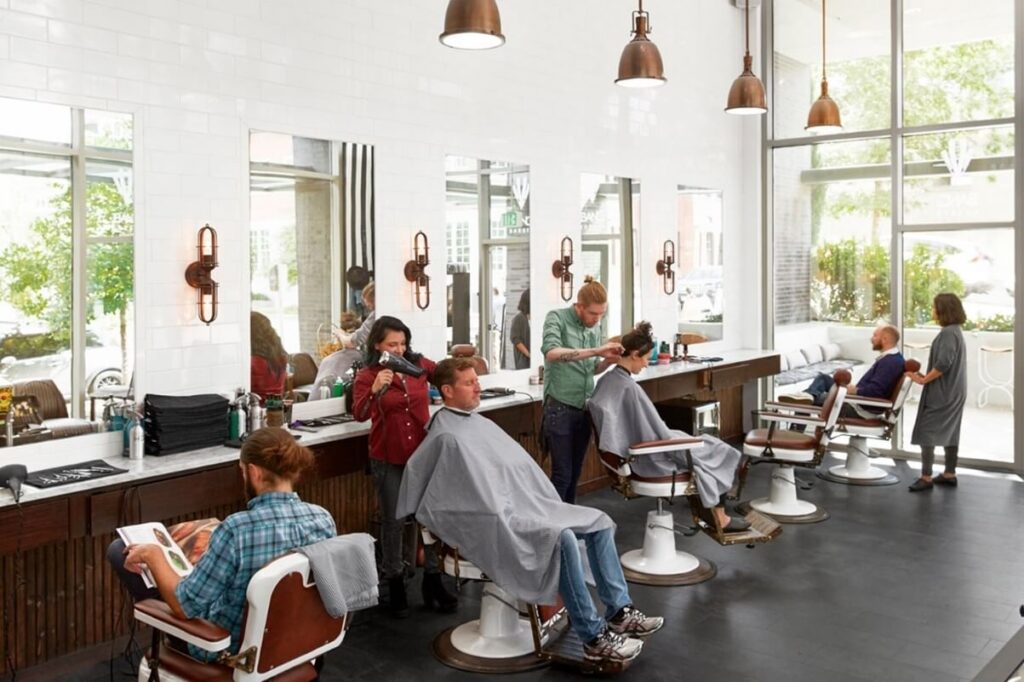Are you considering opening a hair salon?
Despite the challenges, the hair salon industry is thriving, and now is the perfect time to venture into it. However, poor planning is a common reason why many hair salon startups fail. That’s why we’re here to provide you with all the necessary information and resources to help you succeed. From requirements to opening a hair salon to tips on starting with a tight budget, we’ve got you covered.
Save this article for future reference and get ready to turn your dream into reality. Let’s dive into the world of salon business and make your entrepreneurial aspirations come true!

How to Start a Hair Salon Business – 10 Easy Steps
This guide will walk you through the process of planning, registration, and ensuring legal compliance for your new business. By following these steps, you can ensure that your hair salon is well-prepared and set up for long-term success. From creating a solid business plan to fulfilling all the necessary legal requirements, we’ve got you covered.
- Plan your Hair Salon
- Form your Hair Salon into a Legal Entity
- Register your Hair Salon for Taxes
- Open a Business Bank Account & Credit Card
- Set up Accounting for your Hair Salon
- Get the Necessary Permits & Licenses for your Hair Salon
- Get Hair Salon Insurance
- Define your Hair Salon Brand
- Create your Hair Salon Website
- Set up your Business Phone System
How to Start a Hair Salon Steps Explained
STEP 1: Plan your Hair Salon
Having a clear plan is vital for entrepreneurial success in the hair salon industry. Consider key factors such as choosing a business name, understanding startup and ongoing costs, identifying your target market, and determining pricing strategies. Fortunately, we have conducted extensive research to assist you in these areas.
Naming your business:
Selecting an appropriate name is crucial. If you need inspiration, refer to How to Name a Business guide or utilize the Hair Salon Name Generator. For sole proprietorships, operating under a business name other than your own may be preferable.
Registering your business name:
Ensure your chosen name is available by checking your state’s business records, federal and state trademark records, social media platforms, and web domain availability. Securing your domain name early is essential to avoid potential conflicts.
Costs involved in opening a hair salon:
Experts recommend having at least $60,000 in capital, which may vary depending on property costs and the number of chairs (approximately 6 chairs can fit in a 1,000-square-foot space). Equipment typically accounts for around $30,000, while licensing costs vary widely ($100 to $2,000). Advertising expenses, including television and digital ads, should also be considered.

Ongoing expenses for a hair salon:
Owners can anticipate recurring expenses such as salaries, supplies, advertising, equipment replacement, and building costs (e.g., utilities, permits, upgrades).
Target market:
Hair salons thrive with repeat clientele, specifically individuals willing to pay for quality services and those in need of regular treatments.
Revenue generation in a hair salon:
Hair salons generate revenue by offering beautifying services. It’s crucial to determine appropriate profit margins. Review pricing structures of other salons in your area and aim for a balanced approach. While customers have budget limits, excessively low rates may raise suspicions about the quality of work.
Pricing for customers:
The exact pricing will depend on factors such as location, clientele, and stylist experience. Celebrity clients may pay premium prices, with hair services reaching up to $800 and nails up to $200. Establishing a tiered pricing system, with junior stylists charging around $30 for a cut, intermediates around $40, and masters around $50 to $60, is common. Manicures and pedicures can range from $15 for basic treatments to $30 for spa-quality services.
Profitability of a hair salon:
On average, hair salons can expect profits of up to 15% of their total revenue. Additional income can be generated through retail product sales, such as specialty shampoos and conditioners. Adjusting service prices can increase profitability but be cautious about potentially deterring customers.
Enhancing business profitability:
Identify ways to cater to customers’ needs and enhance their appearance. For instance, offer additional services targeting middle-aged women to uplift and rejuvenate aging skin.
Consider inviting cosmetic specialists for special events or introducing new trends like vampire facelifts or sunset colorings to differentiate your salon. Franchising is an option for expansion, although most hair salons operate as single-location businesses.
STEP 2: Form your Hair Salon into a legal entity
The most prevalent types of business structures include sole proprietorship, partnership, limited liability company (LLC), and corporation.
Creating a legal business entity, such as an LLC or corporation, provides essential protection against personal liability in the event of a lawsuit against your hair salon.
You have the option to form an LLC independently and pay minimal state LLC costs, or you can choose to enlist the assistance of reputable LLC service providers for a modest additional fee.
STEP 3: Register your Hair Salon for taxes
Before commencing operations, it is necessary to register for various state and federal taxes.
To initiate the tax registration process, you will need to obtain an Employer Identification Number (EIN), which is a simple and free procedure.
Additionally, there are specific state taxes that may be applicable to your business.
STEP 4: Open a business bank account & credit card
In addition to being a requirement when applying for business loans, opening a business bank account offers several advantages:
- Personal Asset Protection: It separates your personal assets from your company’s assets, providing crucial protection for your personal belongings.
- Streamlined Accounting and Tax Filing: Having a separate bank account for your business makes accounting and tax filing processes much simpler and more organized.
It is also recommended to obtain a business credit card, as it offers the following benefits:
- Expense Separation: By consolidating all your business expenses in one place, a business credit card helps you keep personal and business expenses separate, making financial management more efficient.
- Building Credit History: Utilizing a business credit card enables you to establish and build your company’s credit history. This can be valuable when seeking financing opportunities in the future.
STEP 5: Set up accounting for your Hair Salon
Maintaining accurate and comprehensive financial records is vital for assessing the financial performance of your business. It allows you to track your expenses and income sources effectively. Moreover, keeping well-documented accounts significantly simplifies the process of filing your annual taxes.
STEP 6: Get the necessary permits and licenses for your Hair Salon
Neglecting to obtain the required permits and licenses can lead to substantial penalties and, in extreme cases, the forced closure of your business. It is crucial to ensure compliance with all necessary legal requirements to avoid these adverse consequences.
Obtaining a Certificate of Occupancy involves an inspection of the premises to verify compliance with regulations related to fire safety, electrical systems, plumbing, accessibility, and other applicable criteria. By obtaining this certificate, you demonstrate your commitment to providing a safe and compliant environment for both employees and customers.
STEP 7: Get Hair Salon insurance
Like licenses and permits, your business requires insurance in order to operate safely and legally. Business insurance safeguards your company’s financial well-being in the case of a covered loss.
There are several insurance policies designed for various sorts of organisations with varying risks. If you are unaware of the types of dangers that your company may face, start with General Liability Insurance. This is the most popular coverage that small businesses want, so it’s a good place to start for your company.
Workers’ Compensation Insurance is another important product that many businesses require. If your company will have employees, your state may require you to obtain Workers’ Compensation coverage.
STEP 8: Define your Hair Salon brand
Your salon’s brand is what it stands for, as well as how the public perceives it. A strong brand will help your company stand out from the crowd.
If you already have a logo, you can use this Free QR Code Generator to convert it to a QR code. Choose from 13 different types of QR codes to produce a code for your business cards and publications, or to help spread the word about your new website.
How to Promote and Market a Hair Salon
Find out what a customer wants and then start filling in the blanks. For example, there may not be many salons open late on weeknights, or you may have higher quality color treatments that last longer than other salons. Set up a referral or loyalty program to encourage clients to promote your hair salon. These discounts will ensure that clients promote your business and return for your services.
Your customers are almost certainly on social media, which is an excellent location to sell. Take images of your accomplishments and keep your feed updated – even if interest is modest at first.
How to Keep Customers Returning
Make every customer engagement a success. Customers will connect success with your services as a result, and they will also tell others about your company. Consider the customer experience from every angle: finding the salon, getting there, parking, leaving, and so on. Use sites like Yelp to your advantage, and never leave a complaint unanswered. If you want to grab people’s attention, be generous. Although 10% discount may sound like a lot, it is unlikely to impress someone who already has a relationship with another salon.

STEP 9: Create your Hair Salon website
After you’ve defined your brand and designed your logo, the next step is to build a website for your company.
The following are the primary reasons why you should not put off developing your website:
- Every genuine business has a website, period. When it comes to bringing your business online, it doesn’t matter what size or industry it is.
- Social media accounts, such as Facebook pages or LinkedIn company profiles, are not a replacement for your own business website.
- Website builder programmes, such as the GoDaddy Website Builder, have made it relatively simple to create a basic website. You don’t need to pay a web developer or designer to make a website you’re proud of.
STEP 10: Set up your business phone system
Getting a phone set up for your business is one of the most effective strategies to keep your personal and professional lives distinct and private. That isn’t the only advantage; it also allows you to automate your business, lends it legitimacy, and makes it easier for potential clients to identify and contact you.
Hair Salon Success Stories
Success Story 1: Casey Nickole and BANG Hair Salon
Casey Nickole, the owner of BANG Hair Salon in Seattle, experienced remarkable success with her salon business. Here are some key highlights of her journey:
- Dreaming of Expression and Identity: Casey’s initial vision was to provide a space where clients could express themselves and create a personal identity through hairstyling.
- Steady Growth: Despite facing obstacles, BANG Hair Salon achieved significant growth. In its first year, the salon generated $300,000 in revenue, which increased to over $1 million in the second year.
- Overcoming Challenges: Casey realized that manual processes were hindering BANG’s growth potential. This realization led her to seek a solution that could streamline operations and enhance efficiency.
- Integrated System Solution: To address the challenges faced by BANG, Casey adopted an integrated system that managed various aspects of the business, including payments, inventory tracking, payroll, and customer relationship management (CRM).
- Benefits of Integration: By implementing the integrated system, Casey gained more flexibility, equipped her staff with better information, and improved communication with clients. She could effectively manage appointments across multiple locations and access sales reports for strategic planning.
Strategic Growth: With enhanced operational efficiency and access to valuable insights, Casey was able to strategize for growth effectively. This ultimately led to BANG Hair Salon becoming a multimillion-dollar business with three locations and a team of over forty employees.
Success Story 2: Woody Lovell and the Barbershop Club
Woody Lovell, the owner of the Barbershop Club in Los Angeles, offers valuable advice based on his own success in the business. Here are ten key pieces of advice shared by Woody:
- Simplicity and Humbleness: Woody emphasizes focusing on simplicity and maintaining a humble approach in business.
- Preserve Integrity: He stresses the importance of preserving your integrity as a business owner, ensuring that your actions align with your values.
- Embrace the “Small Feel”: Despite achieving substantial profits, Woody encourages maintaining a “small feel” in your business, fostering a sense of intimacy and personalized service.
- Quality over Quantity: Rather than prioritizing quantity, Woody advocates for delivering high-quality services or products to your customers.
- Invest in Relationships: Building strong relationships with your customers and clients is crucial for long-term success. Foster loyalty and trust.
- Value Your Team: Recognize the contributions of your employees and create a positive work environment that promotes growth and collaboration.
- Adapt and Innovate: Stay updated with industry trends and be willing to adapt your business strategies to meet changing customer demands.
- Embrace Technology: Leverage technology to streamline operations, enhance customer experience, and gain valuable insights.
- Community Involvement: Engage with the local community and support causes that align with your business values.
- Continuous Learning: Never stop learning and seeking ways to improve. Stay curious and open to new ideas and opportunities.
By incorporating these insights and lessons from successful salon owners like Casey Nickole and Woody Lovell, aspiring salon owners can gain inspiration and valuable advice to navigate their own entrepreneurial journey.
Conclusion
While opening a hair salon comes with risks, focusing on the opportunity for success and taking proactive steps to address challenges can lead to significant growth and profitability. By following these steps and learning from successful salon owners, you can lay a strong foundation for your hair salon business and fulfil your entrepreneurial dreams.

